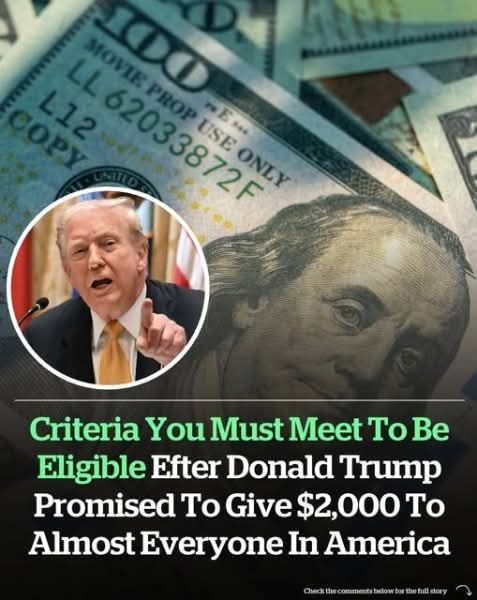When former U.S. President Donald Trump posted a bold economic proposal on Truth Social, it immediately captured national attention. His message was brief but powerful: a promise to create a new revenue stream for everyday Americans using money generated from tariffs. According to Trump, this initiative could provide what he described as “a dividend of at least $2,000 per person,” excluding high-income individuals.
While the proposal has not yet been developed into official policy or legislative text, it has already become one of the most discussed economic ideas in the United States. Supporters praised it as an innovative way to put money directly in the hands of Americans, while critics raised questions about practicality, economic impact, and long-term consequences.
This article explores Trump’s concept from top to bottom — its origins, economic theory, potential mechanisms, possible benefits, and the complex debates surrounding tariffs as a national funding tool. Whether supporters ultimately embrace or reject the idea, one thing is certain: the proposal has reignited a nationwide conversation about taxes, trade, and financial security.
The Announcement: A Promise That Turned Heads
On Truth Social, Trump wrote a series of statements that outlined the broad strokes of his idea. One of the most widely shared excerpts read:
“A dividend of at least $2,000 per person (excluding high-income earners) will be paid to everyone.”
He followed this with a more forceful defense of tariffs:
“People that are against tariffs are FOOLS! We are now the richest, most respected country in the world, with almost no inflation, and a record stock market price.”
The posts did not include a legislative framework, implementation timeline, or economic model, but they were enough to start a nationwide debate. Economists, journalists, political analysts, business leaders, and everyday Americans began asking the same core question:
Can tariffs really fund a national dividend?
Understanding Tariffs: The Foundation of the Proposal
To understand the proposal, it is important to understand tariffs themselves. A tariff is a tax placed on imported goods. The government collects the tax, and the money flows into federal revenue. Trump’s argument rests on three key ideas:
1. Tariffs can generate large federal income.
Tariffs already generate billions each year. Increasing them — or expanding the list of taxed imports — could significantly raise that amount.
2. Higher tariff revenue could be redistributed to Americans.
Similar to the Alaska Permanent Fund, which pays residents dividends funded by oil revenue, Trump’s plan seeks to provide payments funded by trade revenue.
3. Redistributing tariff revenue could reduce taxpayer burden.
If tariffs bring money into the U.S. Treasury, Trump argues it could reduce the need for income taxes, federal borrowing, or inflation-driving stimulus programs.
Why Trump Believes the Plan Would Work
Trump has long been an advocate of tariffs and often argues that they strengthen American industry. His economic philosophy during his presidency included:
- Placing tariffs on steel, aluminum, and other imports
- Imposing tariffs on hundreds of billions of dollars in goods from China
- Negotiating trade deals designed to favor U.S. manufacturing
- Encouraging companies to rely less on foreign supply chains
Supporters of Trump’s new proposal say his track record proves tariffs can generate revenue without raising taxes on American families.
They also argue:
- A tariff-funded dividend could help millions of households
- It could stabilize consumer spending
- It might reduce reliance on government programs
- It could create an economic buffer during downturns
This explains why many of Trump’s supporters quickly embraced the idea online. But experts also responded with serious questions.
Major Questions Surrounding the Proposal
While the idea of sending out $2,000 checks sounds appealing, several important questions remain unanswered.
1. How much revenue would tariffs need to generate?
A dividend of $2,000 per adult would require hundreds of billions of dollars annually, depending on eligibility rules. Current tariff revenue would need to be expanded.
2. Are tariffs the best way to raise that money?
Economists disagree sharply. Critics argue that tariffs can lead to higher consumer prices if companies pass costs to buyers.
3. Would foreign countries retaliate?
Tariffs often trigger counter-tariffs, which can affect exports and American businesses.
4. How would the funds actually be distributed?
Trump mentioned several possibilities, but none were confirmed:
- Tax rebates
- Healthcare credits
- Direct deposit payments
- Annual national dividend checks
The lack of a clear mechanism leaves room for speculation.
Possible Distribution Methods Explained
Even without official details, policy experts have suggested several plausible structures.
1. Direct Cash Payments (Tax-Free Dividend)
This model would resemble stimulus checks. Every eligible American would receive a yearly payment funded by tariff revenue.
2. Tax Rebates
Instead of checks, Americans could receive a reduction in taxes owed at filing time.
3. Healthcare or Insurance Credits
The dividend could offset medical costs, insurance premiums, or prescription expenses.
4. Monthly Installments
Some argue smaller monthly payments could provide smoother financial stability than an annual check.
Each model has advantages and challenges, but without official clarification, all remain hypothetical.
Supporters Argue the Plan Could Strongly Help Working Families
Supporters believe the proposal could benefit ordinary Americans in several ways:
Boosting Household Income
A $2,000 payment could help families cover rent, utilities, food, medical bills, childcare, or savings.
Strengthening the Middle Class
By redistributing trade-related revenue, the plan could ease financial pressure on workers without raising their taxes.
Encouraging U.S. Manufacturing
Tariffs may incentivize companies to produce goods domestically, strengthening American jobs in the long run.
Reducing Dependence on Foreign Producers
Supporters claim greater self-reliance improves national security and economic resilience.
Critics Raise Concerns About Cost, Economics, and Impact on Prices
Critics of tariff expansion argue the opposite:
Higher Prices for Consumers
Tariffs often increase price tags on imported goods — and sometimes even domestic goods.
Financial Pressure on Small Businesses
Many small retailers rely on imported supplies, and higher tariffs could strain profitability.
Uncertain Revenue
Tariff revenue fluctuates depending on global demand, trade volume, and market conditions.
International Trade Tensions
Foreign governments could respond with their own tariffs, affecting American exports such as agriculture.
Critics also question whether a permanent national dividend is financially sustainable.
The Bigger Picture: Americans Want Financial Relief
Regardless of political viewpoints, one thing is clear:
Millions of Americans are struggling with high costs.
From groceries to housing to medical bills, people are seeking relief. In this environment, any proposal promising financial support will naturally attract attention.
Trump’s idea taps into this desire by presenting a seemingly simple formula:
Tax imports → Generate revenue → Pay Americans
Whether simple or not, the idea resonates because it speaks to a national desire for stability, economic fairness, and greater financial opportunity.
Why the Plan Resonates Emotionally
Beyond economics, the proposal touches on deeper themes:
- Financial dignity
- Economic fairness
- National pride
- Support for working families
- Desire for a stronger domestic economy
For many Americans, receiving a yearly dividend funded by trade revenue feels like reclaiming something from global markets rather than sacrificing more.
Could This Become Policy? Unknown — But Not Impossible
At this point, the proposal exists only as a series of public statements, not legislation. However, America has seen similar ideas before:
- Alaska residents receive yearly oil dividends
- Some European nations distribute energy credits
- Universal Basic Income has been debated globally
- Economic stimulus payments have become familiar
A tariff-funded dividend would be a first in U.S. history, but not entirely unprecedented in spirit.
If political conditions align, the concept could evolve into a real proposal.
A Nation Watching, Debating, and Waiting
For now, the country waits for more details.
- Will the plan be formally introduced?
- How would it be structured?
- Who qualifies?
- What imports would be taxed?
- How much money could realistically be raised?
These questions remain unanswered — but they continue to fuel debate across social media, news outlets, and political forums nationwide.
Conclusion: A Bold Idea That Has Sparked a National Conversation
Donald Trump’s tariff-funded dividend proposal is one of the most talked-about economic ideas of the year. Whether one views it as visionary or unrealistic, it has captured the nation’s attention by offering:
- A promise of direct financial support
- A debate about the role of tariffs in modern economics
- A conversation about fairness, revenue, and trade
- A renewed focus on American households and financial security
The idea is far from finalized, but its impact is undeniable.
For now, Americans continue to watch closely — waiting for more details, more clarity, and a deeper understanding of what this proposed dividend could mean for their futures, their families, and the nation as a whole.


